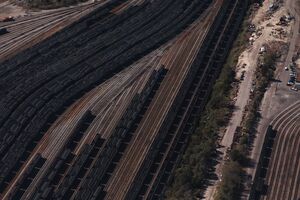Railcar Covers and Lids: Difference between revisions
added details on hopper cars and added photo |
removed combustability line |
||
| Line 1: | Line 1: | ||
One solution to fugitive [[Particulate matter and coal dust|coal dust]] emissions is to cover the train cars with a physical lid. ''To read more about other solutions, like wet suppression systems, go to: [[Chemical Dust Suppression: Sprinklers and Surfactants]]'' | One solution to fugitive [[Particulate matter and coal dust|coal dust]] emissions is to cover the train cars with a physical lid. As uncovered coal trains travel long distances, wind and vibration can release [[Particulate matter and coal dust|fine particulate matter]] into the air. A secure lid system could significantly reduce these emissions by containing the dust at its source. ''To read more about other solutions, like wet suppression systems, go to: [[Chemical Dust Suppression: Sprinklers and Surfactants]]'' | ||
[[File:Lamberts-point-edit-2.jpg|thumb|Uncovered coal hoppers, parked at Pier 6 in Lambert's Point, owned and operated by Norfolk Southern. (SouthWings). 2023.]] | [[File:Lamberts-point-edit-2.jpg|thumb|Uncovered coal hoppers, parked at Pier 6 in Lambert's Point, owned and operated by Norfolk Southern. (SouthWings). 2023.]] | ||
Covered hopper cars, which are equipped with a roof, have historically been used for cargo like grain, sugar, and fertilizer, that must be protected from exposure to the weather. Coal, which can be exposed with minimal effect to the product, has been transported in open hopper cars. In an effort to prevent [[Health impacts: particles and coal dust|dangerous fugitive coal dust]] emissions, some railroads and coal shippers have begun putting covers on the coal as well. However, because of cheaper | Covered hopper cars, which are equipped with a roof, have historically been used for cargo like grain, sugar, and fertilizer, that must be protected from exposure to the weather. Coal, which can be exposed with minimal effect to the product, has been transported in open hopper cars. In an effort to prevent [[Health impacts: particles and coal dust|dangerous fugitive coal dust]] emissions, some railroads and coal shippers have begun putting covers on the coal as well. However, because of cheaper and similarly effective solutions on the market, covering the coal remains a rare choice for dust control. | ||
== Dust Control == | == Dust Control == | ||
A 2004 experiment by Ferreira & Vaz found that the use of covers reduces the amount of dust released to be less than 20% of the quantity eroded from the uncovered wagon. In other words, when compared to the no-cover situation, the semi-cover reduced the dust amount released more than 80% for the full-load situation.<ref>[https://voicesinthedust.org/File:1-s2.0-S0167610504000340-main.pdf Ferreira, A.D, and P.A Vaz. 2004. “Wind Tunnel Study of Coal Dust Release from Train Wagons.” Journal of Wind Engineering and Industrial Aerodynamics 92 (7-8): 565–77. https://doi.org/10.1016/j.jweia.2004.03.003.]</ref> | A 2004 experiment by Ferreira & Vaz found that the use of covers reduces the amount of dust released to be less than 20% of the quantity eroded from the uncovered wagon. In other words, when compared to the no-cover situation, the semi-cover reduced the dust amount released more than 80% for the full-load situation.<ref>[https://voicesinthedust.org/File:1-s2.0-S0167610504000340-main.pdf Ferreira, A.D, and P.A Vaz. 2004. “Wind Tunnel Study of Coal Dust Release from Train Wagons.” Journal of Wind Engineering and Industrial Aerodynamics 92 (7-8): 565–77. https://doi.org/10.1016/j.jweia.2004.03.003.]</ref> | ||
== | == Concerns == | ||
Installing lids involves substantial retrofitting expenses and operational hurdles, as loading terminals and mines would need new infrastructure, and lids complicate fast unloading. Many operators instead favor [[Chemical Dust Suppression: Sprinklers and Surfactants|chemical dust suppressants]], which have been shown to achieve a high reduction in dust at lower cost. | |||
== Documents == | == Documents == | ||
Revision as of 03:04, 12 June 2025
One solution to fugitive coal dust emissions is to cover the train cars with a physical lid. As uncovered coal trains travel long distances, wind and vibration can release fine particulate matter into the air. A secure lid system could significantly reduce these emissions by containing the dust at its source. To read more about other solutions, like wet suppression systems, go to: Chemical Dust Suppression: Sprinklers and Surfactants

Covered hopper cars, which are equipped with a roof, have historically been used for cargo like grain, sugar, and fertilizer, that must be protected from exposure to the weather. Coal, which can be exposed with minimal effect to the product, has been transported in open hopper cars. In an effort to prevent dangerous fugitive coal dust emissions, some railroads and coal shippers have begun putting covers on the coal as well. However, because of cheaper and similarly effective solutions on the market, covering the coal remains a rare choice for dust control.
Dust Control
A 2004 experiment by Ferreira & Vaz found that the use of covers reduces the amount of dust released to be less than 20% of the quantity eroded from the uncovered wagon. In other words, when compared to the no-cover situation, the semi-cover reduced the dust amount released more than 80% for the full-load situation.[1]
Concerns
Installing lids involves substantial retrofitting expenses and operational hurdles, as loading terminals and mines would need new infrastructure, and lids complicate fast unloading. Many operators instead favor chemical dust suppressants, which have been shown to achieve a high reduction in dust at lower cost.
Documents
Research Papers
- Ferreira, A.D., D.X. Viegas, and A.C.M. Sousa. 2003. “Full-Scale Measurements for Evaluation of Coal Dust Release from Train Wagons with Two Different Shelter Covers.” Journal of Wind Engineering and Industrial Aerodynamics 91 (10): 1271–83. https://doi.org/10.1016/s0167-6105(03)00077-1.
- Ferreira, A.D, and P.A Vaz. 2004. “Wind Tunnel Study of Coal Dust Release from Train Wagons.” Journal of Wind Engineering and Industrial Aerodynamics 92 (7-8): 565–77. https://doi.org/10.1016/j.jweia.2004.03.003.